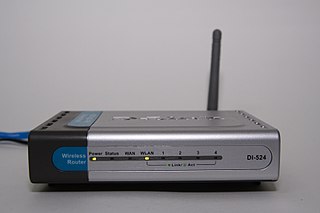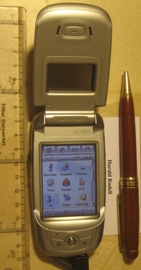
An MFP, multi-functional, all-in-one (AIO), or multi-function device (MFD), is an office machine which incorporates the functionality of multiple devices in one, so as to have a smaller footprint in a home or small business setting, or to provide centralized document management/distribution/production in a large-office setting. A typical MFP may act as a combination of some or all of the following devices: email, fax, photocopier, printer, scanner.

MontaVista Software is a company that develops embedded Linux system software, development tools, and related software. Its products are made for other corporations developing embedded systems and end products using Linux, such as automotive electronics, telecommunications and communications equipment, mobile phones, and other electronic devices and infrastructure. MontaVista also supplies Linux-based solutions and software to products that are software-only, such as enterprise networking, virtual network functions in Network Functions Virtualization, and appliance software that is hosted on a cloud hosting environment.
Computer operating systems based on the Linux kernel are used in embedded systems such as consumer electronics, in-vehicle infotainment (IVI), networking equipment, machine control, industrial automation, navigation equipment, spacecraft flight software, and medical instruments in general.

A wireless router or Wi-Fi router is a device that performs the functions of a router and also includes the functions of a wireless access point. It is used to provide access to the Internet or a private computer network. Depending on the manufacturer and model, it can function in a wired local area network, in a wireless-only LAN, or in a mixed wired and wireless network.
MotoMagx was a Linux kernel-based mobile operating system developed and launched in 2007 by Motorola to run on their mid-to-high-end mobile phones. The system was based on MontaVista's Mobilinux. Originally intended for 60% of their upcoming devices, it was soon dropped in favor of Android and Windows Mobile operating systems.
The Motorola ROKR, the first version of which was informally known as the iTunes phone, was a series of mobile phones from Motorola, part of a 4LTR line developed before the spin out of Motorola Mobility. ROKR models were released starting in September 2005 and ending in 2009. They were notable for incorporating support of media player features.

The Motorola A780 is the second cellular PDA running the Linux operating system.

The Pepper Pad was a family of Linux-based mobile computers with Internet capability and which doubled as a handheld game console. They also served as a portable multimedia device. The devices used Bluetooth and Wi-Fi technologies for Internet connection. Pepper Pads are now obsolete, unsupported and the parent company has ceased operations.
Lightweight Access Point Protocol (LWAPP) is the name of a protocol that can control multiple Wi-Fi wireless access points at once. This can reduce the amount of time spent on configuring, monitoring or troubleshooting a large network. The system will also allow network administrators to closely analyze the network.
LinuxMCE is a free and open source software platform with a 10-foot user interface designed to allow a computer to act as a home theater PC (HTPC) for the living-room TV, personal video recorder, and home automation system. It allows control of everything in the home, from lighting and climate to surveillance cameras and home security. It also includes a full-featured VoIP-compatible phone system with support for video conferencing.

The Tizen Association, formerly the LiMo Foundation, is a non-profit consortium which develops and maintains the Tizen mobile operating system. Tizen is a Linux-based operating system for smartphones and other mobile devices. The founding members were Motorola, NEC, NTT DoCoMo, Panasonic Mobile Communications, Samsung Electronics, and Vodafone. The consortium's work resulted in the LiMo Platform—which was integrated into mobile phone products from NEC, Panasonic and Samsung—and later became the Tizen platform.
Addressability is the ability of a digital device to individually respond to a message sent to many similar devices. Examples include pagers, mobile phones and set-top boxes for pay TV. Computer networks are also addressable via the MAC address on Ethernet network cards, and similar networking protocols like Bluetooth. This allows data to be sent in cases where it is impractical to control exactly where or to which devices the message is physically sent.
The Motorola Razr2 (often stylized as RAZR2) is a series of clamshell/flip mobile phones from Motorola, and is one of the series in the 4LTR line. It is the successor to the popular Razr series. The Razr2 is 2 mm thinner than its predecessor but slightly wider. Some versions feature Motorola's MotoMagx operational platform, based on the MontaVista Linux OS. The Razr2 was made available on every US carrier, and EVDO, GSM and HSDPA versions of it were released by late 2007.

OpenEZX was a project active from 2004 to 2008, which gathered information about the Linux based Motorola EZX phone platform.
Latitude ON is an instant-on computer system made by Dell. It is a combination of software and hardware developed by Dell and used in some of their Latitude laptops. The system is based on a dedicated ARM processor that runs a custom version of a Linux OS. It was announced on August 12, 2008, along with other laptops, including a potential competitor to the Asus Eee PC and arrived a year later on 28 September 2009.

The Motorola A910 is a clamshell mobile phone from Motorola, which uses MontaVista Linux as the operating system.







